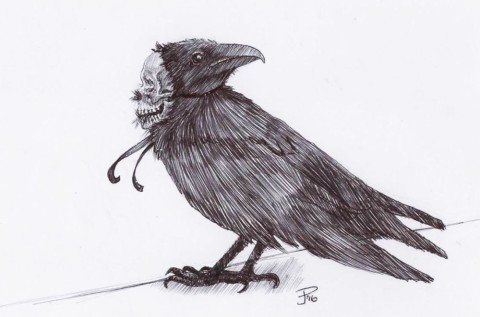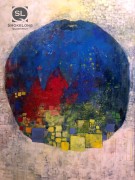On the drive into the city, I pass a crow with a bone in its beak. It perches atop a stop sign at the end of the Montlake exit from the 520 West. I can’t tell what kind of bone – maybe a turkey leg? Or maybe that’s just what I want to think, because I’m pretty sure it’s something else, something bigger, something a crow shouldn’t be able to pluck out of a plundered trashcan, if you know what I mean. The car behind me honks and I have to drive before I can get a better look. The crow watches me the whole time, cocking its head and fixing one knowing, mirror-bright eye on me. It was definitely a bone. I know it, and the crow knows I do.
You saw a crow. My husband sighs. I hear voices in the background; he has to hang up, he’s at work, he doesn’t have time for this.
On the way home, near where I saw the crow, I glimpse a bicycle wheel caught on the branch of an evergreen, far too high for a person to have tossed it there. No sign of the rest of the bike, or a rider, and then the truck behind me honks and I have to move.
I can’t help wondering if these things are related. It’s possible, if the wheel was from a small bicycle, and the bone from a small person. Do you see what I’m getting at?
It’s ridiculous to worry about things like that, my husband says. You’ll never know, and you can’t do anything about it, anyway.
Did you know that crows can recognize and remember faces, and communicate that information to other crows who’ve never encountered those faces? That’s right – they will tell their friends and relatives about people they find threatening, and those birds will gather to mob and scold that person. And maybe worse.
I pore over the Seattle Times, scanning for stories of missing children. Hunter Larsen, age five, last seen riding his bicycle in the driveway of his Magnolia home. The day before his disappearance, he threw a rock at a crow. No. Nothing. Nothing yet. My fingers are black, my face streaked with ink.
You should wash your face, my husband says. You should exercise. You should eat more vegetables.
I don’t see how any of that will help, not when the crows are watching, crows with bones they probably shouldn’t have. Did you know they can fashion and use tools? Did you know they can live up to forty years in the wild?
You should watch less TV, my husband says.
Thanksgiving was eight months ago, so it’s not like there are turkey legs up for grabs around the city. Who eats turkey in July? Besides Disney tourists, I mean. I wonder if Hunter Larsen, age five, ever made it to Disney. I bet he ate a turkey leg. I bet his whole family did. A rafter of turkeys disappearing down the gullets of the Larsen family, shreds of skin and flesh smeared around their gaping maws, Hunter pestering his sister with his bone until she squeals and then screeches and their parents mutter Cut it out without looking up from their phones. Now she’s screaming and they don’t care, nobody cares, everyone screams at The Happiest Place on Earth.
You should get out more.
That crow saw me noticing its bone. I’m not worried. I’m a little worried. You know what I mean. I hope you do.
The point is, we’re a long way from Disney. I can hear them screaming from here.
My husband honks. I have to move on.

Notes from Guest Reader Molia Dumbleton
I was completely captivated by this story. Once I’d read it, I absolutely couldn’t get it out of my head—which was an eerily perfect effect, given the nature of the story itself. It’s one of my favorite-ever representations of an inner voice: doubting itself, judging itself via the imagined eyes of others, spiraling into its own suppositions, and defending itself, needing desperately to prove itself right, all at once.


 The SmokeLong Grand Micro Contest (The Mikey) is now an annual competition celebrating and compensating the best micro fiction and nonfiction online.
The SmokeLong Grand Micro Contest (The Mikey) is now an annual competition celebrating and compensating the best micro fiction and nonfiction online.